A guide to sewing a freestyle backpack purse.
Beginning
Step 1. Let’s sew the straps. We have 4 of those.
If you use fabric, fold the pattern No13 right side inside, stitch the sides together, turn right side out and finish the edges with a topstitch.
If you use leather or artificial leather, trim allowance on the sides of the pattern No13. Glue the edges on the wrong side and fold them toward the center. Finish the edges with a topstitch.
Put the resulting leather/fabric/webbing piece through the metallic frame, thus getting a part of the future strap.
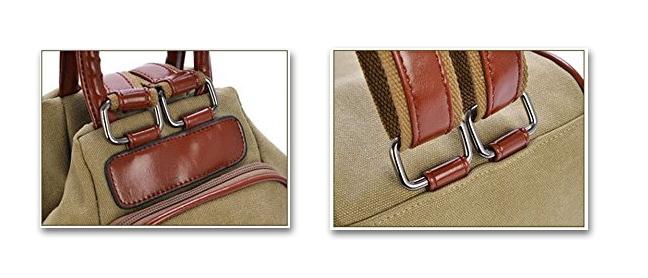
Step 2. Sew the straps to the pattern No5, in accordance with the plotted lines painted on it.
Step 3. Place the pattern No6 (the lower edge) on top of the pattern No5 (the edge with the straps), and stitch with seam allowance, right sides facing each other. Turn the piece right side out and add do a topstitch along the seam (the seam allowance should be facing the bottom, the straps should be facing the back).
Step 4. Now take resulting piece of Step 3, and match up the narrow part of the pattern No5 with the lower edge of the pattern No4, right sides facing each other.
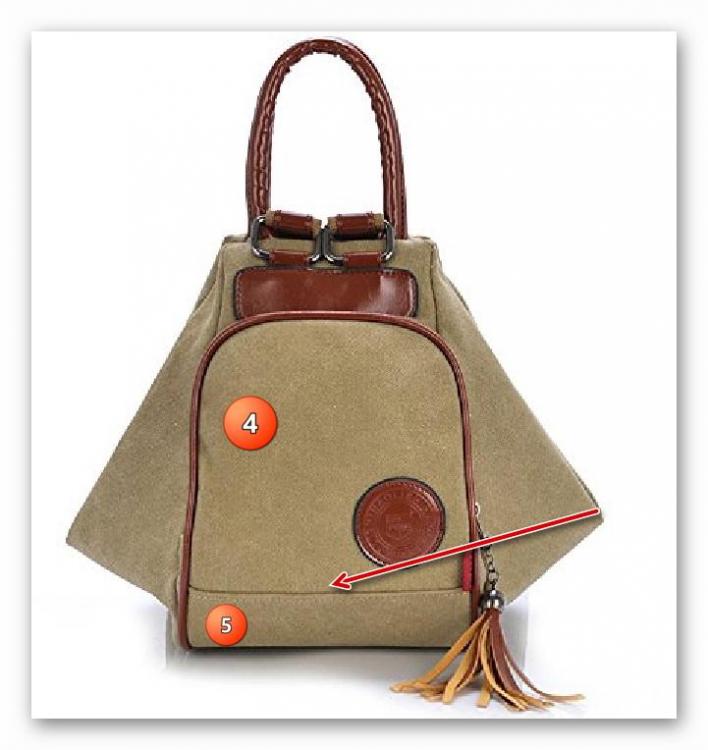
Stitch with seam allowance, fold back to the right side and finish with a topstitch along the seam on the side of the pattern No5 (the seam allowance should be facing toward the bottom).
Step 5. To the resulting piece of Step 4, attach the edging, in accordance with the plotted lines on the pattern No6.
Step 6. Preparing a zipper. Put the parts of the pattern No11 together, their right sides facing each other, so that the short end of the assembly covers a 40 cm long zipper. Stitch with 1 cm seam allowance and then topstitch along the seam.
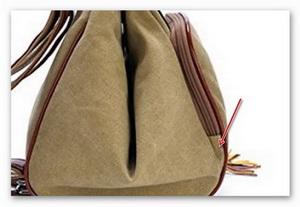
Step 7. Stitch the resulting pieces of Step 5 and Step 6 together, in accordance with the plotted lines. One flange of the zipper is now secured.

Step 8. Place two parts of the pattern No7 (canvas) on top of each other, right sides facing each other, and sew along the lower edge with seam allowance.
Flip both parts back.
Place the resulting piece of Step 7 on the canvas, right sides facing each other, in accordance with the plotted lines. Sew with seam allowance to the edge of the pattern No4 (the assembly with the zipper).
***The beginning and the end of the line of stitching should not overlap the second canvas piece.
Step 9. Turn the Pattern No8 right side out.
Transfer the center point over onto the zipper tape.
Cover it with the second piece of canvas, right sides facing each other, align the centers and the triangular bracings.
Baste and stitch with 0.5 seam allowance.
Step 10. Patch plate on the front.
If you decided to make your patch plate rectangular, fold the edges to the center and do a topstitch along the folding lines.
Sew the last pair of straps to the pattern No12. You may shorten these straps as much as possible.
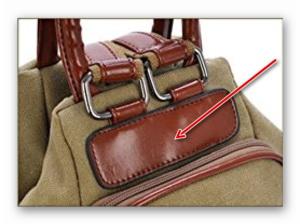
Step 11. Sew the resulting piece of Step 10 to the pattern No3.
Step 12. Sew the resulting piece of Step 11 to the pattern No9, matching up the centers.
Step 13. Now we’re going to sew the short handles.
If you're using fabric, fold the parts of the pattern No10, right sides facing each other, and stitch with seam allowance.
Turn the whole thing right side out, press it with an iron and do a topstitch along the folding lines.
If you're using leather or artificial leather,
glue the long sides to a depth of 2 cm. Hem in the seam allowance, then gently tap the folds with a small hammer.
Fold the result in half and sew the folded hems together.
Add another line of stitching at the same distance, parallel to the first.
Round handle: an alternative.
To make a round handle, you’ll need a cord, preferably the one that has a core. The circumference of the handle will depend on the diameter of the cord. The point here is to match the diameter of the cord to the inner part of the future handle. The cord should be equal to the pattern No10 in length, minus 2 cm of seam allowance.
How to calculate the width of the pattern No10 (the round handle):
Measure the diameter of the cord, if unknown. Add 3–5 mm so that is moves freely, and 2 cm allowance on top of that. That will give you get the necessary width.
Fold the seam allowance to the wrong side. Glue (if you're using leather) or baste (if you’re using fabric). Match up the folded hems and sew.
Using whatever you have at hand, pass the cord through the pattern.
This is how I do it. First, I pick up a thick thread and a needle. Having cut 30 cm of the thread, I secure it at the end of the cord, winding it around several times with a needle. I also have a sturdy strand of wire. Folding it in half; I attach the free end of the thread to the bend.
Then I pass the wire through my future short handle and draw the end of the cord on the other side.
It will take some effort, because there is not too much room inside. It will be an easy journey from here.
We now have the straps.
Step 14. Sew the result of Step 13 (the short handles) to the short edges of the result of Step 12, right sides facing each other, at a distance of 1.5 cm from the corner.
Step 15. Now let’s add our zipper.
Fold the pattern No2 in half and put it on top of your main zipper, close to the teeth, but not too close.
Sew along the folding line at a distance of 3–5 mm from the edge. If the zipper tape is wide, you may add another line of stitching, parallel to the first. Repeat with the second flange.
Be sure to do the reversing to secure the end of the zipper so that it doesn’t pop open.
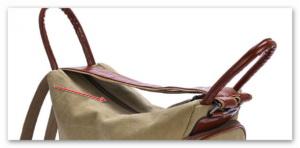
Step 16. Sew the resulting piece of Step 15 to the even edge of the pattern No1 (made of outer fabric), right sides together. Repeat with the second part of pattern No1.
Step 17. If you’re making a bag out of fabric, baste the resulting piece of the Step 14 to the resulting piece of the pattern 16, right sides together, at a distance of 1.5 cm from the upper edge of the pattern No1. Later this assembly will be stitched to the upper edge of the body of the bag.
In order to make a beautiful even seam, use the markings on the pattern No1 that correspond to the markings on the bottom part of the resulting piece of Step 14.
Do not sew the upper edges of the lining to the upper end of the body!
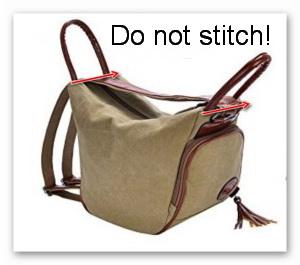
Stitch the basted edges with seam allowance.
Thus we get the future upper part of the backpack.
Step 18. Put the two parts of the pattern No8 together, right sides facing each other, and stitch along the upper and lower edges. Turn right side out through the open sides. If you decided to make two pockets, repeat this last step with the second part of the pattern No8.
Iron out the pocket edges.
Step 19. Sew the resulting piece of Step 18 to the pattern No6, in accordance with the plotted lines. Sew or baste the sides, fixing them in place. Stitch along bottom folding line, thus attaching the lower part of the pocket. Or, you may stitch the pocket in one go: first the right side, then the bottom, and then the left.
Step 20. Now, the lining for the body of your bag.
Align the resulting piece of Step 19 and the pattern No9, and sew with seam allowance along the shorter edge, right sides facing each other.
Press the seam allowance open.
Step 21. Sew the result of the Step 20 with the pattern N1 (the lining), at a distance of 1.5 cm from the upper corner of that pattern. Leave an opening for turning your backpack right side out.
Step 22. Unzip.
Align the upper edges of the result of Step 21 (right side) to the upper edges of the resulting piece of Step 17 (wrong side). Sew with seam allowance.
Step 23. Tuck the outer part of the bag into the lining. Do not turn the whole thing right side out yet.
Align the open side edges of the lining and the zipper. Make sure that the edges of the inside and outside parts of the bag align.
Sew with seam allowance.
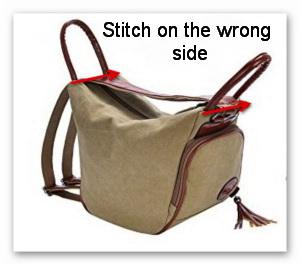
Step 24. Turn the backpack right side out through the opening in the lining.
Tuck the lining into the backpack and check all of the seams for defects.
All good? Then stitch the opening in the lining with a blind stitch.
Step 25. Now let’s prepare the lower parts of the straps.
Use the technique from step 13. We sewed the short handles there.
Step 26. Slide on the strap adjusters.
Detachable straps.
Stitch the strap ends.
Non-detachable straps.
Pass the strap ends through the openings in the front part of the backpack and sew.
Pass the other ends through the openings on the back (the ones on the straps) and then once more through the strap length adjusters, so as to form a second lover loop.
Sewing the edge of the shoulder straps.
P.S. If you find any part of the tutorial difficult, feel free to write a comment, and we’ll try to help.
Please share the photos of your backpacks with us; we’ll be happy to add them to our Gallery!
We’ll be happy to see your creations!

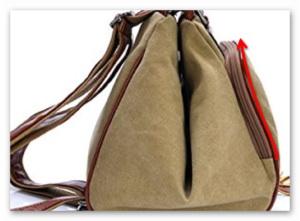


There are no reviews to display.